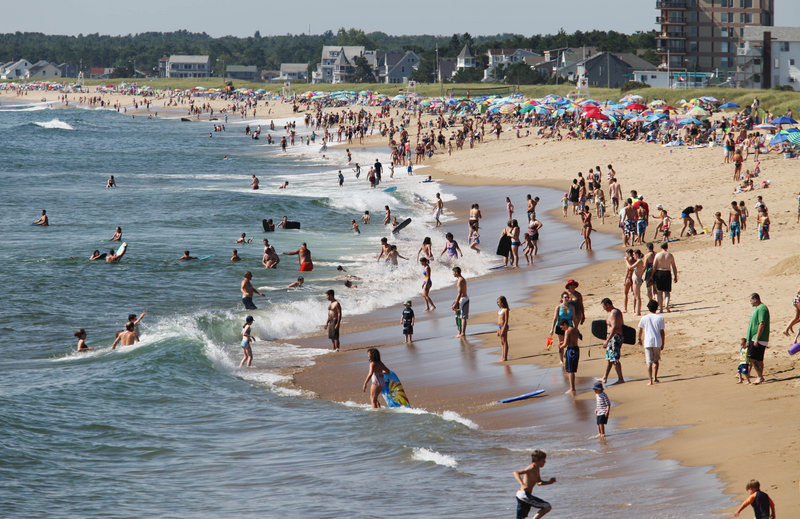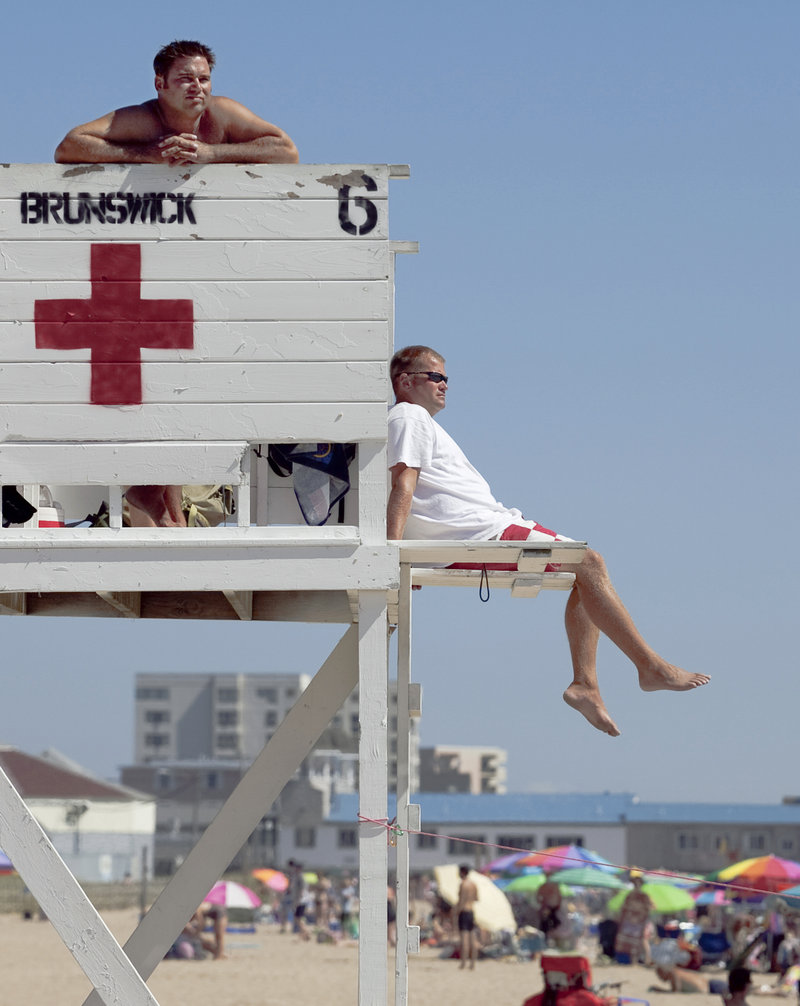OLD ORCHARD BEACH – Big crowds and strong rip currents are making this a busy summer for lifeguards at beaches in southern Maine and New Hampshire.
Lifeguards at Old Orchard Beach had rescued 93 swimmers as of Wednesday, making it the busiest summer in memory for those guarding the four-mile stretch of beach.
It’s the same story at New Hampshire’s busiest beach. Lifeguards at Hampton Beach have assisted or rescued 75 swimmers.
Lifeguards blame winter storms that carved up the ocean floor and redistributed sand, creating rip currents, also known as rip tides. At the same time, this summer’s hot, sunny weather has drawn many people to the beaches.
“It’s all about the beach erosion. It’s created mini-rips. Usually we’re sitting around here waiting for hurricane season for things to get busy,” Wes Rhames said Wednesday from his lifeguard stand overlooking Old Orchard Beach.
Rip currents, which account for 80 percent of lifeguards’ beach rescues, can pull an unsuspecting swimmer out to sea. They’re created by changes in the contour of the sandy bottom.
In Old Orchard Beach, most of the problems this summer are linked to sandbars. A swimmer who wades along a sandbar can step into a rip current that’s created when part of the sandbar washes way.
Those swimmers find themselves in over their heads — literally — and fighting a strong current, said Keith Willett, chief lifeguard at Old Orchard Beach. A week ago, lifeguards rescued two dozen swimmers in a single afternoon because of strong surf and rip currents.
In New Hampshire, erosion of sandbars is causing similar problems on the north side of Hampton Beach, said Alex Valhouli, deputy chief of lifeguards. A swimmer can be wading in 2 feet of water and then step into 12 feet of water because of the unpredictable nature of the sandbars, he said.
At the same time, beaches have been crowded every day of the week because of a months-long run of warm temperatures and sunny skies.
“We can’t remember summers like this as far as the weather. It’s been a phenomenal summer, weather-wise,” Valhouli said.
This summer’s balmy weather is in stark contrast to last summer, when Mainers lamented the rainy weather and Old Orchard Beach lifeguards sat through June and July with no rescues. This summer, the number of rescues will easily top 100, Willett said.
At Hampton Beach, there are about 25 rescues in a slower summer, so the 75 assists so far this summer is much more than normal, Valhouli said.
To save themselves, swimmers are told not to fight rip currents. Instead, they should swim parallel to the beach to escape the rip, then swim back to shore.
Lifeguards say swimmers can protect themselves by checking with lifeguards on surf conditions, and by swimming only in places that are monitored by guards.
Last year, 117 swimmers drowned at the nation’s beaches, but only 21 deaths happened at beaches where lifeguards were present, said Chris Brewster of the U.S. Lifesaving Association. All told, there were 82,969 reported rescues from 114 reporting agencies, Brewster said.
For all the rescues, it has been a relatively safe summer in Maine, with only one fatality. Last month, Anne McNaughton Farley of Westbrook died after jumping into the water at an unguarded beach in Saco to rescue her grandchild. She saved the child but was unable to make it back to shore.
On Wednesday, sunbathers in Old Orchard Beach seemed unfazed by the rip currents.
“You feel pretty good when you have lifeguards here,” said Mark Baker of Salem, N.H., who was playing ball with his 12-year-old son, Ben, on the beach near the main lifeguard station. “From what I understand, a lot of beaches don’t even have lifeguards.”
Send questions/comments to the editors.




Success. Please wait for the page to reload. If the page does not reload within 5 seconds, please refresh the page.
Enter your email and password to access comments.
Hi, to comment on stories you must . This profile is in addition to your subscription and website login.
Already have a commenting profile? .
Invalid username/password.
Please check your email to confirm and complete your registration.
Only subscribers are eligible to post comments. Please subscribe or login first for digital access. Here’s why.
Use the form below to reset your password. When you've submitted your account email, we will send an email with a reset code.